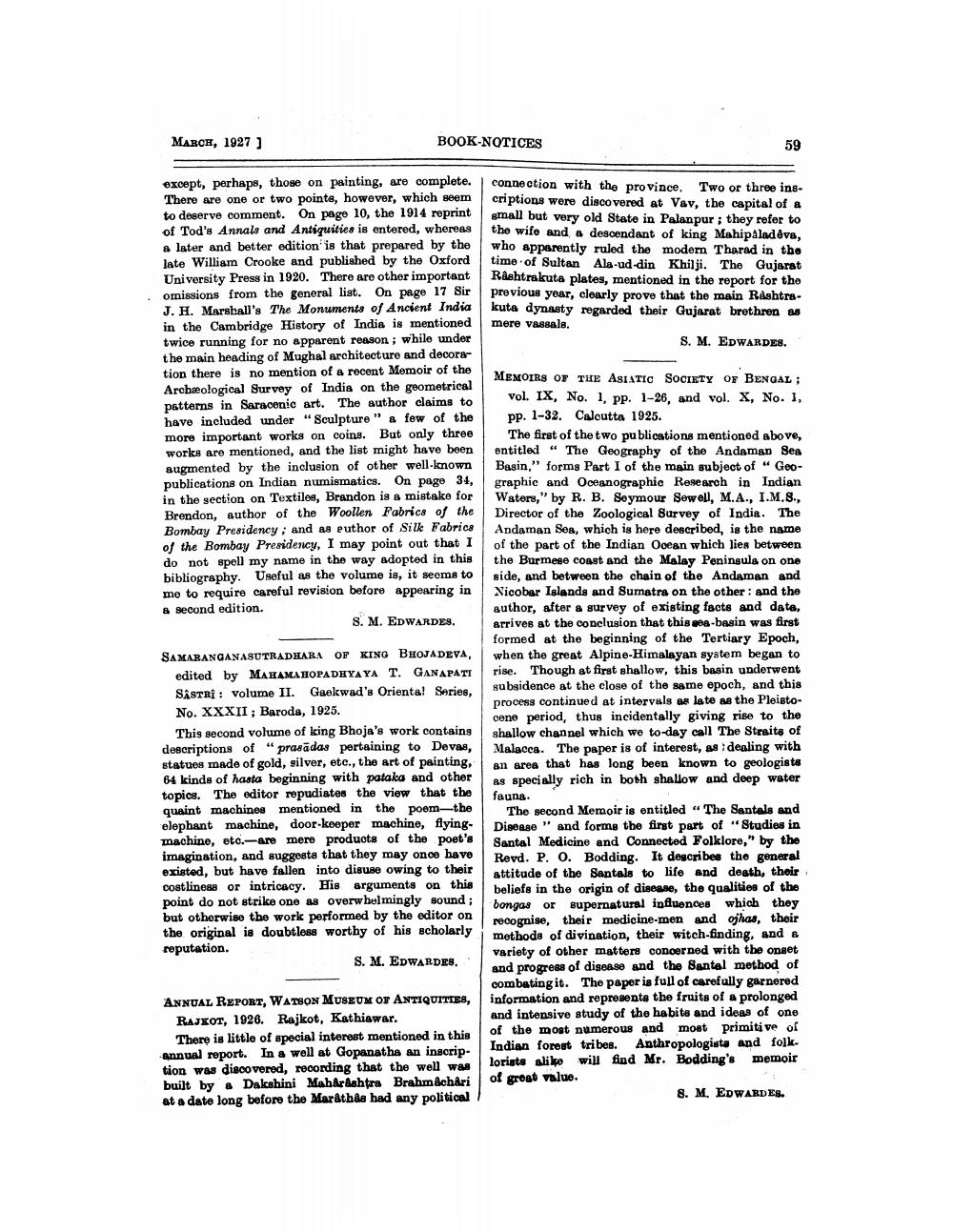________________
MARCH, 1927 ]
BOOK-NOTICES
59
connection with the province. Two or three inscriptions were discovered at Vav, the capital of a small but very old State in Palanpur ; they refer to the wife and a descendant of king Mahipaladeva, who apparently ruled the modern Tharad in the time of Sultan Ala-ud-din Khilji. The Gujarat Rashtrakuta plates, mentioned in the report for the previous year, clearly prove that the main Rashtrakuta dynasty regarded their Gujarat brethren as mere vassals.
S. M. EDWARDES.
except, perhaps, those on painting, are complete. There are one or two points, however, which seem to deserve comment. On page 10, the 1914 reprint of Tod's Annals and Antiquities is entered, whereas
later and better edition is that prepared by the late William Crooke and published by the Oxford University Press in 1920. There are other important omissions from the general list. On page 17 Sir J. H. Marshall's The Monuments of Ancient India in the Cambridge History of India is mentioned twice running for no apparent reason; while under the main heading of Mughal architecture and decora tion there is no mention of a recent Memoir of the Archaeological Survey of India on the geometrical patterns in Saracenic art. The author claims to have included under "Sculpture" & few of the more important works on coins. But only three works are mentioned, and the list might have been augmented by the inclusion of other well-known publications on Indian numismatics. On page 34, in the section on Textiles, Brandon is a mistake for Brendon, author of the Woollen Fabrics of the Bombay Presidency; and as euthor of Silk Fabrics of the Bombay Presidency, I may point out that I do not spell my name in the way adopted in this bibliography. Useful as the volume is, it seems to me to require careful revision before appearing in & second edition.
S. M. EDWARDES.
SAMARANGANASUTRADHARA OF KING BHOJADEVA,
edited by MATAMA HOPADHYAYA T. GANAPATI SASTRI : Volume II. Gaekwad's Oriental Series, No. XXXII ; Baroda, 1925.
This second volume of king Bhoja's work contains descriptions of "prasādas pertaining to Devas, statues made of gold, silver, etc., the art of painting, 64 kinds of hasta beginning with pataka and other topics. The editor repudiates the view that the quaint machines mentioned in the poem the elephant machine, door-keeper machine, flyingmachine, etc.-are mere products of the poet's imagination, and suggests that they may once have existed, but have fallen into disuse owing to their costliness or intricacy. His arguments on this point do not strike one as overwhelmingly sound; but otherwise the work performed by the editor on the original is doubtless worthy of his scholarly reputation.
S. M. EDWARDES.
MEMOIRS OF THE ASIATIC SOCIETY OF BENGAL ;
vol. IX, No. 1, pp. 1-26, and vol. X, No. 1, pp. 1-32. Calcutta 1925.
The first of the two publications mentioned above, entitled " The Geography of the Andaman Sea Basin," forms Part I of the main subject of “ Geographic and Oceanographic Research in Indian Waters," by R. B. Seymour Sewell, M.A., I.M.S., Director of the Zoological Survey of India. The Andaman Sea, which is here described, is the name of the part of the Indian Ooean which lies between the Burmese coast and the Malay Peninsula on one side, and between the chain of the Andaman and Nicobar Islands and Sumatra on the other and the author, after a survey of existing facts and data, arrives at the conclusion that this sea-basin was first formed at the beginning of the Tertiary Epoch, when the great Alpine-Himalayan system began to rise. Though at first shallow, this basin underwent subsidence at the close of the same epoch, and this process continued at intervals as late as the Pleistocene period, thus incidentally giving rise to the shallow channel which we to-day call The Straits of Malacca. The paper is of interest, as dealing with an area that has long been known to geologists as specially rich in both shallow and deep water fauna.
The second Memoir is entitled “The Santals and Disease" and formg the first part of "Studies in Santal Medicine and Connected Folklore," by the Revd. P. O. Bodding. It describes the general attitude of the Santals to life and death, their beliefs in the origin of disease, the qualities of the bongas or supernatural influences which they recognise, their medicine-men and ojhas, their methods of divination, their witch-finding. And & variety of other matters concerned with the onget and progress of disease and the Santal method of combating it. The paper is full of carefully garnered information and represents the fruits of a prolonged and intensive study of the habits and ideas of one of the most numerous and most primitive of Indian forest tribes. Anthropologists and folk. loristo alilo will find Mr. Bodding's memoir of great value.
8. M. EDWARDES.
ANNUAL REPORT, WATSON MUSEUM OF ANTIQUITIES,
RAJKOT, 1926. Rajkot, Kathiawar.
There is little of special interest mentioned in this annual report. In a well at Gopanatha an inscription was discovered, recording that the well was built by a Dakshini Maharashtra Brahmachari at a date long before the Marathas had any political




